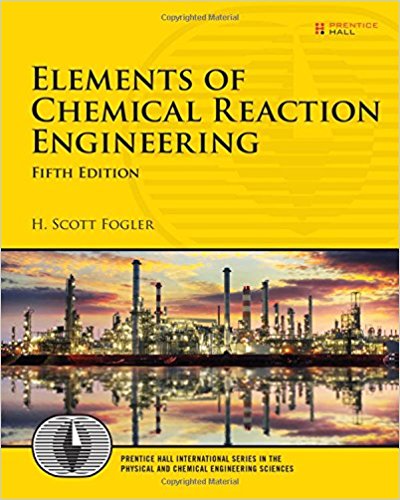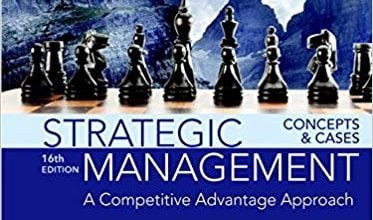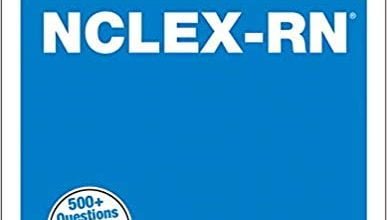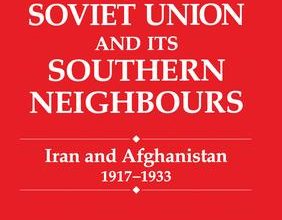
دانلود ایبوک Elements of Chemical Reaction Engineering, Fifth Edition
برای دانلود نسخه 5 ام کتاب Elements of Chemical Reaction Engineering سال 2016 که در آرشیو گیگاپیپر موجود است، با ما مکاتبه کنید. پس از واریز هزینه PDF کتاب ارسال می شود.
cost of Ebook is 15$ .Email us to download the ebook. To be sure, you can request to submit several sample pages from the book.
مشخصات کتاب Elements of Chemical Reaction Engineering, Fifth Edition

Download Ebook
Elements of Chemical Reaction Engineering (5th Edition) (Prentice Hall International Series in the Physical and Chemical Engineering Sciences) 5th Edition
By: H. Scott Fogler
Publisher: Prentice Hall
Pub. Date: January 7, 2016
Web ISBN-13: 978-0-13-388782-2
Web ISBN-10: 0-13-388782-0
Print ISBN-13: 978-0-13-388751-8
Print ISBN-10: 0-13-388751-0
Pages in Print Edition: 992
بررسی اجمالی ایبوک elements of chemical reaction engineering fogler 5th edition
Overview
Other Titles in This Category
Analysis, Synthesis, and Design of Chemical Processes, Fifth Edition
Richard C. Bailie; Wallace B. Whiting; Joseph A. Shaeiwitz; Richard Turton; Debangsu Bhattacharyya
Basic Electrical and Electronics Engineering
S. K. Bhattacharya; D. Devaraj
The Architectural Expression of Environmental Control Systems
George Baird
The End of Error
John L. Gustafson
El gas natural en España
Alfonso Ballestero
The Definitive, Fully Updated Guide to Solving Real-World Chemical Reaction Engineering Problems
Elements of chemical reaction engineering 5th edition pdf download
For decades, H. Scott Fogler’s Elements of Chemical Reaction Engineering has been the world’s dominant text for courses in chemical reaction engineering. Now, Fogler has created a new, completely updated fifth edition of his internationally respected book. The result is a refined book that contains new examples and problems, as well as an updated companion Web site. More than ever, Fogler has successfully integrated text, visuals, and computer simulations to help both undergraduate and graduate students master all of the field’s fundamentals. As always, he links theory to practice through many relevant examples, ranging from standard isothermal and non-isothermal reactor design to applications, such as solar energy, blood clotting, and drug delivery, and computer chip manufacturing.
To promote the transfer of key skills to real-life settings, Fogler presents the following three styles of problems:
Straightforward problems that reinforce the principles of chemical reaction engineering
Living Example Problems (LEPs) that allow students to rapidly explore the issues and look for optimal solutions
Open-ended problems that encourage students to practice creative problem-solving skills
About the Web Site
The companion Web site offers extensive enrichment opportunities and additional content, including
elements of chemical reaction engineering 5th edition download pdf
Complete PowerPoint slides for lecture notes for chemical reaction engineering classes.
Links to additional software, including POLYMATH™, Matlab™, Wolfram Mathematica™, AspenTech™, and COMSOL™.
Interactive learning resources linked to each chapter, including Learning Objectives, Summary Notes, Web Modules, Interactive Computer Games, Solved Problems, FAQs, additional homework problems, and links to Learncheme.
Living Example Problems that provide more than eighty interactive simulations, allowing students to explore the examples and ask “what-if” questions. The LEPs are unique to this book.
Professional Reference Shelf, which includes advanced content on reactors, weighted least squares, experimental planning, laboratory reactors, pharmacokinetics, wire gauze reactors, trickle bed reactors, fluidized bed reactors, CVD boat reactors, detailed explanations of key derivations, and more.
Problem-solving strategies and insights on creative and critical thinking.
فهرست مطالب کتاب elements of chemical reaction engineering fogler 5th
1: Mole Balances —
2: Conversion and Reactor Sizing —
3: Rate Laws —
4: Stoichiometry —
5: Isothermal Reactor Design: Conversion —
6: Isothermal Reactor Design: Moles and Molar Flow Rates —
7: Collection and Analysis of Rate Data —
8: Multiple Reactions —
9: Reaction Mechanisms, Pathways, Bioreactions, and Bioreactors —
10: Catalysis and Catalytic Reactors —
11: Nonisothermal Reactor Design—The Steady-State Energy Balance and Adiabatic PFR Applications —
12: Steady-State Nonisothermal Reactor Design : Flow Reactors with Heat Exchange —
13: Unsteady-State Nonisothermal Reactor Design —
14: Mass Transfer Limitations in Reacting Systems —
15: Diffusion and Reaction —
16: Residence Time Distributions of Chemical Reactors —
17: Predicting Conversion Directly from the Residence Time Distribution —
18: Models for Nonideal Reactors —
Appendix A: Numerical Techniques —
Appendix B: Ideal Gas Constant and Conversion Factors —
Appendix C: Thermodynamic Relationships Involving the Equilibrium Constant —
Appendix D: Software Packages —
Appendix E: Rate Law Data —
Appendix F: Nomenclature —
Appendix G: Open-Ended Problems —
Appendix H: Use of Computational Chemistry Software Packages —
Appendix I: How to Use the CRE Web Resources
elements of chemical reaction engineering 5th edition pdf
Table of Contents
About This E-Book
Title Page
Copyright Page
Dedication Page
Contents
Preface
A. Who Is the Intended Audience?
B. What Are the Goals of This Book?
C. What Is the Structure of CRE?
D. What Are the Components of the CRE Web Site?
E. Why Do We Assign Homework Problems?
F. What Is a Living Example Problem (LEP)?
G. What Software Is Available to Solve the LEPs?
H. Are There Other Web Site Resources?
I. How Can Critical Thinking and Creative Thinking Skills Be Enhanced?
I.2 Enhance Creative Thinking Skills
J. What’s New in This Edition?
J.2 Content
K. How Do I Say Thank You?
About the Author
1. Mole Balances
1.1 The Rate of Reaction, –rA
1.2 The General Mole Balance Equation
1.3 Batch Reactors (BRs)
1.4 Continuous-Flow Reactors
1.4.1 Continuous-Stirred Tank Reactor (CSTR)
1.4.2 Tubular Reactor
1.4.3 Packed-Bed Reactor (PBR)
1.5 Industrial Reactors
Summary
CRE Web Site Materials
Questions and Problems
Questions
Problems
Supplementary Reading
2. Conversion and Reactor Sizing
2.1 Definition of Conversion
2.2 Batch Reactor Design Equations
2.3 Design Equations for Flow Reactors
2.4 Sizing Continuous-Flow Reactors
2.5 Reactors in Series
2.5.1 CSTRs in Series
2.5.2 PFRs in Series
2.5.3 Combinations of CSTRs and PFRs in Series
2.5.4 Comparing the CSTR and PFR Reactor Volumes and Reactor Sequencing
2.6 Some Further Definitions
Summary
Summary
CRE Web Site
Questions and Problems
Questions
Problems
Supplementary Reading
3. Rate Laws
3.1 Basic Definitions
3.2 The Reaction Order and the Rate Law
3.2.1 Power Law Models and Elementary Rate Laws
3.2.2 Nonelementary Rate Laws
3.2.3 Reversible Reactions
3.3 Rates and the Reaction Rate Constant
3.3.1 The Rate Constant k
3.3.2 The Arrhenius Plot
3.4 Present Status of Our Approach to Reactor Sizing and Design
Summary
CRE Web Site Materials
Questions and Problems
Questions
Problems
Supplementary Reading
4. Stoichiometry
4.1 Batch Systems
4.2 Flow Systems
4.2.1 Equations for Concentrations in Flow Systems
4.2.2 Liquid-Phase Concentrations
4.2.3 Gas-Phase Concentrations
4.3 Reversible Reactions and Equilibrium Conversion
Summary
CRE Web Site Materials
Questions and Problems
Questions
Problems
Supplementary Reading
elements of chemical reaction engineering 5th edition pdf free download
5. Isothermal Reactor Design: Conversion
5.1 Design Structure for Isothermal Reactors
5.2 Batch Reactors (BRs)
5.2.1 Batch Reaction Times
5.3 Continuous-Stirred Tank Reactors (CSTRs)
5.3.1 A Single CSTR
5.3.2 CSTRs in Series
5.4 Tubular Reactors
5.5 Pressure Drop in Reactors
5.5.1 Pressure Drop and the Rate Law
5.5.2 Flow Through a Packed Bed
5.5.3 Pressure Drop in Pipes
5.5.4 Analytical Solution for Reaction with Pressure Drop
5.5.5 Robert the Worrier Wonders: What If…
5.6 Synthesizing the Design of a Chemical Plant
Summary
ODE Solver Algorithm
CRE Web Site Materials
Questions and Problems
Questions
Problems
Supplementary Reading
6. Isothermal Reactor Design: Moles and Molar Flow Rates
6.1 The Molar Flow Rate Balance Algorithm
6.2 Mole Balances on CSTRs, PFRs, PBRs, and Batch Reactors
6.3 Application of the PFR Molar Flow Rate Algorithm to a Microreactor
6.4 Membrane Reactors
6.5 Unsteady-State Operation of Stirred Reactors
6.6 Semibatch Reactors
6.6.1 Motivation for Using a Semibatch Reactor
6.6.2 Semibatch Reactor Mole Balances
Summary
ODE Solver Algorithm
CRE Web Site Materials
Questions and Problems
Questions
Problems
Supplementary Reading
7. Collection and Analysis of Rate Data
7.1 The Algorithm for Data Analysis
7.2 Determining the Reaction Order for Each of Two Reactants Using the Method of Excess
7.3 Integral Method
7.4 Differential Method of Analysis
7.5 Nonlinear Regression
7.6 Reaction-Rate Data from Differential Reactors
7.7 Experimental Planning
Summary
CRE Web Site Materials
Questions and Problems
Questions
Problems
Supplementary Reading
8. Multiple Reactions
8.1 Definitions
8.2 Algorithm for Multiple Reactions
8.3 Parallel Reactions
8.3.1 Selectivity
8.3.2 Maximizing the Desired Product for One Reactant
8.3.3 Reactor Selection and Operating Conditions
8.4 Reactions in Series
8.5 Complex Reactions
8.5.1 Complex Gas-Phase Reactions in a PBR
8.5.2 Complex Liquid-Phase Reactions in a CSTR
8.5.3 Complex Liquid-Phase Reactions in a Semibatch Reactor
8.6 Membrane Reactors to Improve Selectivity in Multiple Reactions
8.7 Sorting It All Out
8.8 The Fun Part
Summary
CRE Web Site Materials
Questions and Problems
Questions
Problems
Supplementary Reading
elements of chemical reaction engineering fogler 5th edition pdf
9. Reaction Mechanisms, Pathways, Bioreactions, and Bioreactors
9.1 Active Intermediates and Nonelementary Rate Laws
9.1.1 Pseudo-Steady-State Hypothesis (PSSH)
9.1.2 Why Is the Rate Law First Order?
9.1.3 Searching for a Mechanism
9.1.4 Chain Reactions
9.2 Enzymatic Reaction Fundamentals
9.2.1 Enzyme–Substrate Complex
9.2.2 Mechanisms
9.2.3 Michaelis–Menten Equation
9.2.4 Batch-Reactor Calculations for Enzyme Reactions
9.3 Inhibition of Enzyme Reactions
9.3.1 Competitive Inhibition
9.3.2 Uncompetitive Inhibition
9.3.3 Noncompetitive Inhibition (Mixed Inhibition)
9.3.4 Substrate Inhibition
9.4 Bioreactors and Biosynthesis
Cell Growth and Division
9.4.1 Cell Growth
9.4.2 Rate Laws
9.4.3 Stoichiometry
9.4.4 Mass Balances
9.4.5 Chemostats
9.4.6 CSTR Bioreactor Operation
9.4.7 Wash-Out
Summary
CRE Web Site Materials
Problems
Supplementary Reading
10. Catalysis and Catalytic Reactors
10.1 Catalysts
10.1.1 Definitions
10.1.2 Catalyst Properties
10.1.3 Catalytic Gas-Solid Interactions
10.1.4 Classification of Catalysts
10.2 Steps in a Catalytic Reaction
10.2.1 Step 1 Overview: Diffusion from the Bulk to the External Surface of the Catalyst
10.2.2 Step 2 Overview: Internal Diffusion
10.2.3 Adsorption Isotherms
10.2.4 Surface Reaction
10.2.5 Desorption
10.2.6 The Rate-Limiting Step
10.3 Synthesizing a Rate Law, Mechanism, and Rate-Limiting Step
10.3.1 Is the Adsorption of Cumene Rate-Limiting?
10.3.2 Is the Surface Reaction Rate-Limiting?
10.3.3 Is the Desorption of Benzene Rate-Limiting?
10.3.4 Summary of the Cumene Decomposition
10.3.5 Reforming Catalysts
10.3.6 Rate Laws Derived from the Pseudo-Steady-State Hypothesis (PSSH)
10.3.7 Temperature Dependence of the Rate Law
10.4 Heterogeneous Data Analysis for Reactor Design
10.4.1 Deducing a Rate Law from the Experimental Data
10.4.2 Finding a Mechanism Consistent with Experimental Observations
10.4.3 Evaluation of the Rate-Law Parameters
10.4.4 Reactor Design
10.5 Reaction Engineering in Microelectronic Fabrication
10.5.1 Overview
10.5.2 Chemical Vapor Deposition
10.6 Model Discrimination
10.7 Catalyst Deactivation
10.7.1 Types of Catalyst Deactivation
10.7.2 Reactors That Can Be Used to Help Offset Catalyst Decay
10.7.3 Temperature–Time Trajectories
10.7.4 Moving-Bed Reactors
10.7.5 Straight-Through Transport Reactors (STTR)
Summary
CRE Web Site Materials
Questions and Problems
Questions
Problems
Supplementary Reading
elements of chemical reaction engineering 5th edition pdf free download
11. Nonisothermal Reactor Design—The Steady-State Energy Balance and Adiabatic PFR Applications
11.1 Rationale
11.2 The Energy Balance
11.2.1 First Law of Thermodynamics
11.2.2 Evaluating the Work Term
11.2.3 Overview of Energy Balances
11.3 The User-Friendly Energy Balance Equations
11.3.1 Dissecting the Steady-State Molar Flow Rates to Obtain the Heat of Reaction
11.3.2 Dissecting the Enthalpies
11.3.3 Relating ΔHRx (T), , and ΔCP
11.4 Adiabatic Operation
11.4.1 Adiabatic Energy Balance
11.4.2 Adiabatic Tubular Reactor
11.5 Adiabatic Equilibrium Conversion
11.6 Reactor Staging
11.7 Optimum Feed Temperature
Summary
CRE Web Site Materials
Questions and Problems
Questions
Problems
Supplementary Reading
12. Steady-State Nonisothermal Reactor Design—Flow Reactors with Heat Exchange
12.1 Steady-State Tubular Reactor with Heat Exchange
12.2 Balance on the Heat-Transfer Fluid
12.3 Algorithm for PFR/PBR Design with Heat Effects
12.3.1 Applying the Algorithm to an Exothermic Reaction
12.3.2 Applying the Algorithm to an Endothermic Reaction
12.4 CSTR with Heat Effects
The Term in the CSTR
12.4.1 Heat Added to the Reactor
12.5 Multiple Steady States (MSS)
12.5.1 Heat-Removed Term, R(T)
12.5.2 Heat-Generated Term, G(T)
12.5.3 Ignition-Extinction Curve
12.6 Nonisothermal Multiple Chemical Reactions
12.6.1 Energy Balance for Multiple Reactions in Plug-Flow Reactors
12.6.2 Parallel Reactions in a PFR
12.6.3 Energy Balance for Multiple Reactions in a CSTR
12.6.4 Series Reactions in a CSTR
12.6.5 Complex Reactions in a PFR
12.7 Radial and Axial Variations in a Tubular Reactor
12.7.1 Molar Flux
12.7.2 Energy Flux
12.7.3 Energy Balance
12.8 Safety
Summary
CRE Web Site Materials
Questions and Problems
Questions
Problems
Supplementary Reading
13. Unsteady-State Nonisothermal Reactor Design
13.1 The Unsteady-State Energy Balance
13.2 Energy Balance on Batch Reactors (BRs)
13.2.1 Adiabatic Operation of a Batch Reactor
13.2.2 Case History of a Batch Reactor with Interrupted Isothermal Operation Causing a Runaway Reaction
13.3 Semibatch Reactors with a Heat Exchanger
13.4 Unsteady Operation of a CSTR
13.5 Nonisothermal Multiple Reactions
Summary
CRE Web Site Materials
Questions and Problems
Questions
Problems
Supplementary Reading
elements of chemical reaction engineering 5th edition amazon
14. Mass Transfer Limitations in Reacting Systems
14.1 Diffusion Fundamentals
14.2 Binary Diffusion
14.2.1 Evaluating the Molar Flux
14.2.2 Diffusion and Convective Transport
14.2.3 Boundary Conditions
14.2.4 Temperature and Pressure Dependence of DAB
14.2.5 Steps in Modeling Diffusion to a Reacting Surface
14.2.6 Modeling Diffusion with Chemical Reaction
14.3 Diffusion Through a Stagnant Film
14.4 The Mass Transfer Coefficient
14.4.1 Correlations for the Mass Transfer Coefficient
14.4.2 Mass Transfer to a Single Particle
14.4.3 Mass Transfer–Limited Reactions in Packed Beds
14.4.4 Robert the Worrier
14.5 What If . . . ? (Parameter Sensitivity)
Summary
CRE Web Site Materials
Questions and Problems
Questions
Problems
Journal Critique Problems
Supplementary Reading
15. Diffusion and Reaction
15.1 Diffusion and Reactions in Homogeneous Systems
15.2 Diffusion and Reactions in Spherical Catalyst Pellets
15.2.1 Effective Diffusivity
15.2.2 Derivation of the Differential Equation Describing Diffusion and Reaction in a Single Catalyst Pellet
15.2.3 Writing the Diffusion with the Catalytic Reaction Equation in Dimensionless Form
15.2.4 Solution to the Differential Equation for a First-Order Reaction
15.3 The Internal Effectiveness Factor
15.3.1 Isothermal First-Order Catalytic Reactions
15.3.2 Effectiveness Factors with Volume Change with Reaction
15.3.3 Internal Diffusion Limited Reactions Other Than First Order
15.3.4 Weisz–Prater Criterion for Internal Diffusion Limitations
15.4 Falsified Kinetics
15.5 Overall Effectiveness Factor
15.6 Estimation of Diffusion- and Reaction-Limited Regimes
15.7 Mass Transfer and Reaction in a Packed Bed
15.8 Determination of Limiting Situations from Reaction-Rate Data
15.9 Multiphase Reactors in the Professional Reference Shelf
15.10 Fluidized Bed Reactors
15.11 Chemical Vapor Deposition (CVD)
Summary
elements of chemical reaction engineering pdf download
CRE Web Site Materials
Questions and Problems
Questions
Problems
Journal Critique Problems
Supplementary Reading
16. Residence Time Distributions of Chemical Reactors
16.1 General Considerations
16.2 Measurement of the RTD
16.2.1 Pulse Input Experiment
16.2.2 Step Tracer Experiment
16.3 Characteristics of the RTD
16.3.1 Integral Relationships
16.3.2 Mean Residence Time
16.3.3 Other Moments of the RTD
16.3.4 Normalized RTD Function, E(Θ)
16.3.5 Internal-Age Distribution, I(α)
16.4 RTD in Ideal Reactors
16.5 PFR/CSTR Series RTD
16.6 Diagnostics and Troubleshooting
Summary
Summary
CRE Web Site Materials
Questions and Problems
Supplementary Reading
17. Predicting Conversion Directly from the Residence Time Distribution
17.1 Modeling Nonideal Reactors Using the RTD
17.2 Zero-Adjustable-Parameter Models
17.2.1 Segregation Model
17.2.2 Maximum Mixedness Model
17.3 Using Software Packages
17.4 RTD and Multiple Reactions
Summary
CRE Web Site Materials
Questions and Problems
Questions
Problems
Supplementary Reading
elements of chemical reaction engineering 5th edition pdf free download
18. Models for Nonideal Reactors
18.1 Some Guidelines for Developing Models
18.2 The Tanks-in-Series (T-I-S) One-Parameter Model
18.3 Dispersion One-Parameter Model
18.4 Flow, Reaction, and Dispersion
18.4.1 Balance Equations
18.4.2 Boundary Conditions
18.4.3 Finding Da and the Peclet Number
18.4.4 Dispersion in a Tubular Reactor with Laminar Flow
18.4.5 Correlations for Da
18.4.6 Experimental Determination of Da
18.5 Tanks-in-Series Model versus Dispersion Model
18.6 Numerical Solutions to Flows with Dispersion and Reaction
18.7 Two-Parameter Models—Modeling Real Reactors with Combinations of Ideal Reactors
18.7.1 Real CSTR Modeled Using Bypassing and Dead Space
18.7.2 Real CSTR Modeled as Two CSTRs with Interchange
18.8 Use of Software Packages to Determine the Model Parameters
18.9 Other Models of Nonideal Reactors Using CSTRs and PFRs
18.10 Applications to Pharmacokinetic Modeling
Summary
CRE Web Site Materials
Questions and problems
Questions
Problems
Supplementary Reading
A. Numerical Techniques
B. Ideal Gas Constant and Conversion Factors
C. Thermodynamic Relationships Involving the Equilibrium Constant
D. Software Packages
D.1 Polymath
D.2 MATLAB
D.3 Aspen
D.4 COMSOL Multiphysics
E. Rate-Law Data
F. Nomenclature
G. Open-Ended Problems
H. Use of Computational Chemistry Software Packages
I. How to Use the CRE Web Resources
I.1 CRE Web Resources Components
I.2 How the Web Can Help Your Learning Style
I.3 Navigation
Index
دانلود رایگان کتاب Elements of Chemical Reaction Engineering (سه صفحه جهت اطمینان)

Ebook
صفحه 161 کتاب






